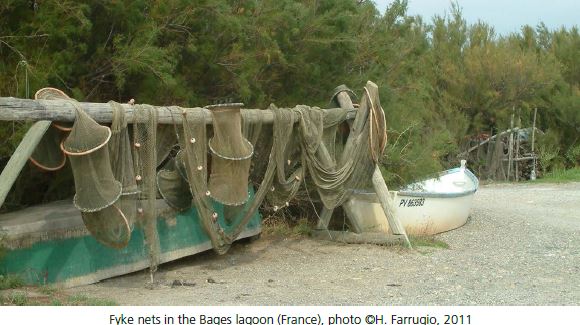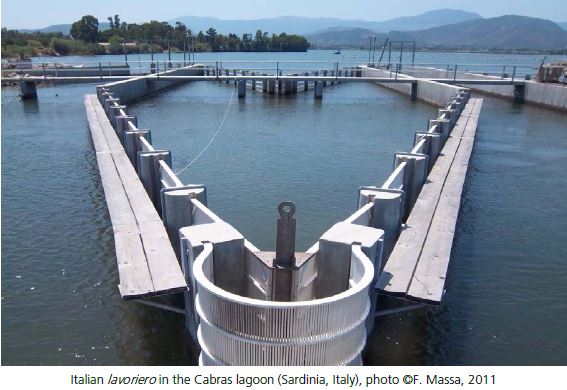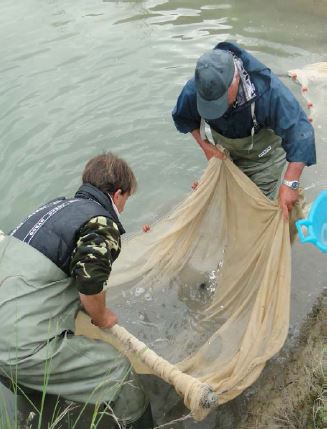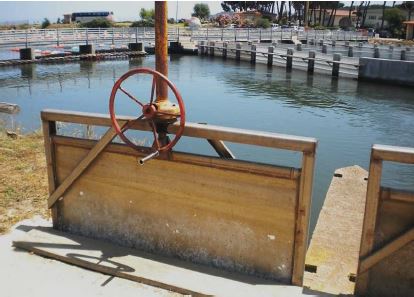2.5. Management of fishing activities in coastal lagoons: capture fisheries and aquaculture
Fishing and extensive aquaculture have always been practised in Mediterranean coastal lagoons for the abundance of trophic resources and for the relative easiness of fishing activities, which occur in a confined and rather protected environment compared with open sea. Coastal lagoon fisheries mainly rely on the capture of euryhaline fish species migrating between the sea and the lagoons during their seasonal movements: mounting of juveniles to the lagoons where conditions are suitable for growth, and returning of adult fish to sea to spawn.
In many cases, artisanal fisheries are well developed, whereas management is simple and mostly based on natural recruitment, a characteristic of a large number of Mediterranean lagoons.
However, simple fishing models have evolved more or less gradually over time towards more sophisticated lagoon management schemes. The history of lagoon exploitation for fishing purposes is therefore closely intertwined with the rise of aquaculture practices, from the set-up of permanent capture systems to intercept the seasonal migration of several species to the enhancement of natural trophic webs to increase lagoon productivity, and hence that of selected target species and to the management of hydraulic flows to control environmental factors in lagoons.
Lagoon fisheries often merge typical aquaculture with capture fisheries management schemes and are sometimes described as “enhanced fisheries”, “capture-based aquaculture” or “extensive aquaculture”. Welcomme (1997) classifies within the aquaculture category all fisheries practices carried out in coastal lagoons. The FAO defines aquaculture as “the farming of aquatic organisms in inland and coastal areas, involving intervention in the rearing process to enhance production and the individual or corporate ownership of the stock being cultivated”. According to this definition, it can be inferred that those coastal lagoons which are characterized by the presence of hydraulic control systems (both freshwater and seawater), fixed traps at lagoons mouths for the capture of migrating fish or by exclusive production ownership can all be considered as “extensive aquaculture systems”.
For instance, fish stocking practices (see paragraph 2.5.2) have been traditionally carried out to sustain the fish production of Mediterranean lagoons in specific confined areas such as in the northern Adriatic valli or in the Egyptian hoshas8 .
8 Ponds devoted to aquaculture inside a lagoon (Egypt country report) usually built with mud and reed dykes (FAO, 1988). 22
These stocking practices represent management models that can be ascribed to privately owned extensive aquaculture. On the contrary, enhanced capture fisheries through restocking in open waters are generally operated by public administrations.
In light of this, it is clear that the major distinction between capture fisheries and aquaculture becomes more than ever difficult in coastal lagoons. Historically, these two different management forms have taken advantage one from the other and developed together into unique forms of exploitation that coexist at present within the very same environment and rely on the same trophic resources.

Fish harvesting in Veta La Palma (Spain), photo ©PIMSA, 2011
2.5.1 Artisanal and fixed fishing gear
The physical confinement of coastal lagoons, consequent to natural events or human interventions, as well as the need to intercept as many fish as possible, have driven in time traditional capture fisheries to integrate with simple forms of aquaculture, at first, and then to develop into more complex fishing systems. At present, capture fisheries in lagoons can still be considered as forms of artisanal fisheries which target more than one species (multispecies fisheries) and make use of a wide variety of fishing gear such as: fyke nets, baskets, traps (fixed), trammel and gillnets (not fixed). Fishing gear design reflects not only local traditions and skills but also a deep knowledge of species biology (e.g. reproduction timing, migrations, seasonal or daily movements due to tides, etc.).

Fisher at dusk (Veta La Palma, Spain), photo ©K. Rodriguez, 2011 
Fyke nets in the Bages lagoon (France), photo ©H. Farrugio, 2011
The development of fixed structures, such as barriers and weirs, to enclose and trap fish in confined areas within lagoons and facilitate their
In colder Mediterranean lagoons, most captures of euryhaline fish take place in winter, in coincidence with seaward migrations; as the water temperature drops, fish attempt to move to the sea where temperatures are milder.
Commercial size fish are retained and captured thanks to the barriers.
In the northern Adriatic valli, non market sized fish are led to wintering ponds (Italian peschiere), where the depth, shape and geographical orientation towards the dominant winds keep the pond temperature above 4–5°C and fish can survive. Wintering channels with an average depth of less than one meter are also present in Greek estuaries (Makridis and Papazi, 2008).
capture can be considered as one of the first steps towards aquaculture. Several manworks to improve coastal lagoon exploitation were already built by the Etruscans and the Ancient Romans and some of these remains can be observed today along the Italian western coast (Giacopini et al., 1994). The basic principle of the functioning of artificial structures in lagoons is the interception of fish when trying to return to the sea.
Some of the most famous lagoon devices are the V-shaped fish traps called “barriers” (the Italian lavorieri or the French bordigues), which allow fish to enter in the lagoon while at the same time preventing their exit. The structure (shape and number of chambers), size, design, building materials (reeds, concrete or metal) of these fixed devices have greatly evolved through centuries and differ among countries according to the local traditions and to the degree of technology achieved; however the fishing efficiency of any of these structures can be considered to reach 100 percent.
Pauly and Yanez Aranciribja (1994) have carried out a detailed study on the role of Mediterranean fish barriers in the context of lagoon fisheries evolution and confirmed that these structures were an important tool for lagoon management and a key element that had progressively led to sophisticated fisheries regimes implying cooperation and high management skills. 
Italian lavoriero in the Cabras lagoon (Sardinia, Italy), photo ©F. Massa, 2011
2.5.2 Stocking and restocking practices
Since the natural entrance of fry and juveniles into the lagoons has decreased in recent times, also as a result of the transformation of the surrounding territory and the control of water flows, fishers have felt the need to start increasing fish biomass by integrating the natural lagoon population
through restocking9 and stocking10 practices. Juveniles of selected species are harvested in the wild. Coastal areas and estuaries are fishing grounds that are exploited by specialized fish fry fishers (in due time according to their life cycle). The development of new means of equipped transport has enabled to collect fry and juveniles far away from the lagoons that are to be restocked.
Restocking usually relies on fry and juveniles belonging to several species. Restocking programmes should always keep in consideration the lagoon food chain structure, which is site-specific; moreover, the number of omnivorous (e.g. grey mullets) and predator species (e.g. gilthead seabream, European seabass and eel) should be ecologically balanced. Ardizzone et al. (1988) have reported several examples of restocking programmes in the northern Adriatic valli: (i)
3 875 fish/ha (3–7 kg/ha) of which 80 percent of grey mullets, six percent of gilthead seabream, six percent of European seabass, eight percent of yellow eels; (ii) 1 000 juveniles/ha of which one percent gilthead seabream, three percent European seabass, 120 yellow eels
Restocking practices have become very important in the northern Adriatic valli as the communication of
these complex lagoon systems with the open sea as well as the number of mounting fish able to return to the lagoons have progressively
decreased in time. In the late 1990s, the valli were annually stocked with around 40 million grey mullet fry, 3 million gilthead seabream and 3 million European seabass captured in the wild (Franzoi et al, 1999).
9 Restocking (or stock enhancement) is the practice of putting artificially reared young fish into their natural environment to let them grow (Cooke, 1984; FAO, 2003).
10 Fish stocking is the process of moving live organisms to a rearing unit (e.g. nursery ponds, fattening ponds) so that ongrowing or reproduction (e.g. in spawning ponds) may take place (AQUALEX, 1998).
(50 specimen/kg) and grey mullets. Ravagnan (1978) reported a restocking event where 70 percent of the fry had been lost immediately after being released in the lagoon due to the stress caused by capture and transport: only 2–3 percent survived and contributed to the restocking of the lagoons. However, Cataudella et al. (2001) reported higher survival rates, up to 15–20 percent for grey mullets and 30–80 percent for seabream.
In Italian lagoons, to increase the survival rate of fry, grey mullet fry captured in fall is often overwintered in land-based ponds and released into the lagoon in spring when the fish have reached a larger size and have more chances to survive as they are subject to lower predation. However, fry survival rates remain difficult to be determined in extensive systems (Ardizzone et al., 1988).
Recently, the availability of fry captured in the wild has also decreased and most restocking is carried out with hatchery produced fry, fingerlings and shrimp post-larvae, which enables a constant supply to the semi-intensive ponds located in the coastal lagoon areas.
Nevertheless, some of the production obtained with traditional restocking from hatcheries had to be discarded over time due to a high rate of malformed fish raised. In order to lessen these events, restocking in some lagoons has been carried out with wild-like type of fry and juveniles, which are released from the hatcheries into the aquatic mesocosms (Cataudella et al., 2002); during this phase a certain degree of natural selection is wielded on the juveniles and only those fish which survive (wild-like fish) are released into the lagoon.

Fish fry collection in the Venice lagoon (Italy), photo ©R. Lazzarini, 2011
In Egypt, wild marine fish fry for aquaculture is collected by licensed fishers under the
supervision of the General Authority for Fisheries Resources Development (GAFRD). The quantity of fry provided through this channel ranges from 90 to 120 million fry per year, most of which are grey mullet although other marine fish species such as meagre, gilthead seabream and seabass can also be found. Stock enhancement programmes are also performed with freshwater species in low salinities lagoons; Burullus and Edku have been restocked from 2004 to 2007 with fish seed from governmental hatcheries, 3 millions of grass carp fry (Ctenopharyngodon idella) (which do not reproduce in the wild in Egyptian waters), 8 millions of Nile tilapia fry
(Oreochromis niloticus) have been released in the Burullus lagoon and about 4 millions Nile tilapia fry in the Edku lagoon; however no data are available on the success of this restocking (Sadek, 2001).
11 Specific pools designed to provide a limited body of water with close to natural conditions, in which environmental factors can be realistically manipulated.
2.5.3 Hydraulic management
A correct hydraulic management helps control and maintain the ecological characteristics of lagoons and hence boost the production. Mediterranean climatic conditions favour natural water exchange mostly in spring, when circulation between the lagoon and the sea increases, contributing to enhancing the trophic migration into the lagoons of euryhaline fish living at sea. In summer, with hot sunny days and low precipitations, the water evaporates and the salinity increases, thus reducing water layers mixing and the death of macrophytes. This process could lead to an excessive eutrophication and to qualitative and quantitative changes in the vegetation composition and, eventually, to macro- and micro-algal blooms. In such conditions, the vegetation mass at the surface layer prevents the sunlight from penetrating into the lagoon, precluding photosynthesis in deeper layers where the degradation of organic matters becomes anaerobic.
In general, with low tide regimes, water exchange with the sea, either periodically or all year round, is quite limited, and a correct hydraulic management through human intervention becomes thus more than ever important. For example, in emergencies, when water circulation and exchange have to be enhanced, hydraulic devices allow water to be artificially pumped into lagoons in order to avoid dystrophic crises (e.g. in the Orbetello lagoon, Italy). Additionally, as movements of sediments by currents and wave action along the coast cause a siltation of the mouth, continuous cleaning of communications channels between the lagoon and the sea is required. Hydraulic management not only facilitates water circulation within the lagoon and between the lagoon and the sea, but also contributes to enhance the distribution of trophic resources and the migration of juveniles into the lagoons and attract fish during the migrating phase, thus stimulating a positive rheotaxis12
behaviour of many fish species (Ardizzone et al., 1988).
Hydraulic works related to coastal lagoons date back to pre-Roman and Roman times, as revealed by the remains that can still be observed in some Italian coastal lagoons (Giacopini et al., 1994). Nowadays, in the most equipped lagoons, hydraulic management consists in the opening/closure of communications with the sea through sluice gates to control the water flow inside the coastal lagoon and thus partly regulate environmental parameters such as temperature, dissolved oxygen, salinity and nutrient content, in particular during periods of freshwater input
(if any). Sometimes, lagoon openings are prone to clogging, and dredging operations are very expensive and can absorb up to 80 percent of the total maintenance costs (e.g. Egyptian lagoons in the Nile delta, Egypt country report). Nevertheless, in several Mediterranean coastal lagoons, no hydraulic management is performed and the water flow merely depends on tide, winds, sea storms and rainfalls.
The the Orbetello lagoon (Italy) has undergone five extensive dystrophic crises in the last 30 years (Lenzi et al,
2011). In Greece, almost 50 percent of the coastal lagoons do not receive a direct freshwater input and the increased damming of rivers has led to reduce river flow and terrestrial sediment input; anoxic conditions and the release of hydrogen sulphide have caused a massive mortality of fish and shellfish communities in the Papas Lagoon, in the Ionian Sea (Greece country report). In the lagoon of Nador (Morocco), a new gateway was built in 2010 to increase the exchange of marine water between the sea and the lagoon from 12 million m3/day (old gateway) to 22 million m3/day (Morocco country report). The Bardawil lagoon (Egypt) represents an extreme case where the absence of hydraulic management could cause the complete dry up of the lagoon (Ben Tuvia, 1979).
12 Positive rheotaxis is a form of taxis seen in many aquatic organisms, such as fish, whereby they (generally) turn to face into an oncoming current (Montgomery et al, 1997).
The role of hydraulic management strongly supports the evidence that the survival of coastal lagoons over time is closely related to human interventions that enable to safeguard their existence but could also cause their disappearance from the coastal landscape if other types of landscape interventions are conducted. Indeed, land reclamation, and more generally the intensive use of flood plains, deeply modify lagoon ecosystem boundaries: flow control modifies sand supplies and sedimentation, altering the natural dynamics that have regulated and shaped coastal water bodies for thousands of years.

Sluice gate in the Tortoli Lagoon (Sardinia, Italy), photo ©D. Crosetti, 2011
2.5.4 Other uses of coastal lagoons
Coastal lagoons are important drivers for regional economies, not only for the income derivating from fisheries and aquaculture, but also for their touristic appeal. Tourism development of coastal lagoon areas includes the expansion of urban settlements, the widening of channels to be used as boat harbours and even the creation of artificial beaches (Perez-Ruzafa et al., 2010). In parallel, various activities such as swimming, diving, sailing, sightseeing on boats, bird watching, recreational fishing, trekking along natural paths around coastal lagoons shores, hunting, wildlife protection, reed harvesting, cattle grazing, leech collection, research and training (see also Turkey country report) can be developed and increased in order to enhance the economic value of the area.
Coastal lagoons also offer an important opportunity to promote the protection of the environment and aquatic resources through ecotourism activities involving fishers, such as, for instance, fisheries tourism in Turkey (Turkey country report), ittioturismo and pescaturismo in Sardinia and Tuscany (Italy country report). The aim of these forms of ecotourism is to diversify exploitation focusing on the integration of fishing within naturalistic, educational and recreational activities and to reduce fishing effort while providing a supplementary income for fishers.

A sign indicating tourism fishing activities in the Tortoli lagoon (Sardinia, Italy), photo ©D. Crosetti, 2011
Public participation in leisure activities as well as information and communication about fishing culture in coastal lagoons certainly contribute to a correct use of aquatic lagoon ecosystems, fisheries resources and aquaculture, improved awareness of the sociocultural aspects connected to lagoons fisheries and the preservation of the lagoons’ cultural heritage.
The laws and regulations in force in Mediterranean countries suggest that a further development of fishing ecotourism activities is to be expected. In Italy for example, specific laws lay out frameworks for fishing tourism as a diversification measure (Law n. 96 of 20/02/2006; Legislative Decree n. 4 of 09/01/2012). Moreover, within the wetlands enhancement project called “Zoumgest”, developed within the framework of the Operational Programme “Italy – Maritime France 2007?2013” some interesting guidelines addressed to all fishing operators in coastal lagoons who are pursuing or wish to pursue multifunctional activities for ecotourism, fishing and recreational tourism have been published (Saba, 2012).
Coastal lagoons situated within national or regional parks benefit from the parks’ strict regulations aimed at protecting and preserving wildlife and biodiversity and preventing any consumptive use of the area. The Pontinian coastal lakes – Monaci, Fogliano and Caprolace – on the west coast of Italy are an example: they are located within the boundaries of the Circeo national park where capture fisheries are now banned. In other Italian parks, fishing activities are still practised, as in the Lesina lagoon (Gargano national park), or in the valli of Comacchio (Parco Regionale delta Po), where fishing activities are permitted with the aim of preserving and handing on the local cultural heritage (Italy country report).